At a glance
- UV rays cause photo-oxidative degradation in polymers, leading to chalking, cracking, and brittleness in standard truck body liners.
- UV-stabilised UHMWPE liners maintain strength, surface quality, and appearance over time.
- For fleets in high-UV environments, UV stability reduces replacement costs and improves reliability.
Australia experiences some of the highest ultraviolet (UV) radiation levels globally, particularly in exposed inland and northern regions. This constant exposure presents a significant durability challenge for truck body liners used in open-tray vehicles, tipper bodies, and construction fleets.
While operators often prioritise impact resistance or slide performance, UV stability is an equally important factor for maintaining long-term liner performance. Without UV protection, standard polymers such as polyethylene gradually lose strength and surface quality under sunlight.
This article examines why UV-stabilised UHMWPE liners provide a longer-lasting solution for fleets operating in the harsh Australian outdoors.
Impact of UV Rays on a Truck Bed Liner
Ultraviolet (UV) rays are a high-energy form of sunlight that can break down unprotected truck body liner materials over time.
In polymers commonly used in truck bed liners, such as polyethylene and polypropylene, prolonged exposure to UV light triggers a reaction known as photo-oxidative degradation, which weakens the material structure.
Here are some of the common impacts of UV rays on truck body liners.
- Surface chalking, where the outer layer becomes powdery and flakes away.
- Cracking and embrittlement reduce the liner’s ability to handle load flex or tipping impact.
- Roughened texture, which interferes with smooth tipping and makes cleaning more difficult.
- Fading and discolouration, affecting visual presentation and professionalism.
Unlike liners that rely on surface coatings, UV-stabilised UHMWPE liners, such as OKUSLIDE® Premium Blue, are engineered with stabilising additives integrated throughout the material. This protects the entire liner from UV degradation, ensuring longer-lasting performance in high-UV and exposed operating environments.
Read More: Why Choose OKUSLIDE® UHMWPE Lining: Top Features and Benefits
Why UV Stability Is Important for Truck Bed Liners
UV stability refers to a material’s ability to resist deterioration when exposed to ultraviolet radiation over time. For commercial truck body liners, this means retaining mechanical strength and surface performance despite ongoing sun exposure.
High-performance liners achieve UV stability by integrating UV-stabilising additives directly into the polymer compound. This differs from cheaper liners that depend on surface coatings, which wear away quickly during regular tipping cycles.
While UV-stabilised liners may cost more upfront than standard options, they deliver better value over time by extending service life and reducing unplanned replacements. The focus should be on long-term operational benefits rather than short-term savings.
Here are some of the most common reasons why UV stability is important for a truck bed liner:
Structural integrity
UV radiation damages polymer materials through a process called chain scission. This process breaks down molecular bonds over time, weakening the structural integrity of the material. As this damage accumulates, the liner’s flexibility decreases, and the material becomes brittle and weak.
A brittle liner is prone to cracking under heavy tipping loads and repeated vibration. Once cracks form, they often spread quickly, compromising the liner’s ability to reduce wear on the underlying truck body.
UV-stable liners help maintain mechanical integrity over time, enabling longer service life and more reliable performance in industries such as mining, agriculture and construction.
Operational Safety
As liners degrade under UV exposure, they often develop surface inconsistencies, such as microcracks, rough patches, or chalky residue. While these may not seem significant at first, they directly affect how materials move across the liner surface during tipping.
Irregular liner surfaces can disrupt flow, cause uneven material release, or lead to unexpected shifting during tipping cycles. These issues make unloading less predictable and compromise safety, particularly in high-load operations.
In comparison, UV-stable liners help preserve a uniform, low-friction surface, maintaining consistent material movement and supporting a safer, more predictable tipping experience on site.
Cost Efficiency and Operational Uptime
UV degradation often leads to premature liner failure long before the material reaches the end of its abrasion or wear cycle. This hidden form of damage starts at the surface and progresses inward, undermining mechanical strength even in fleets that do not regularly handle highly abrasive loads.
As a result, operators may face more frequent liner replacements, increased downtime during relining, and added labour hours that are avoidable with the correct material choice.
UV-stable composite liners reduce the need for early changeouts, extend service intervals, and help minimise disruptions to transport schedules. For fleets working across remote, high-UV environments, UV-stable truck body liners are a practical, long-term investment.
Maintaining Consistent Slide Performance
Low-friction liners play a critical role in enabling clean tipping by minimising hang-up and supporting even material flow. However, prolonged UV exposure can damage the surface texture of standard liners. Over time, microcracks, rough patches, and inconsistent contact points can significantly affect material flow.
UV-stabilised liners help maintain a smoother, lower-friction surface over time. This preserves tipping efficiency and allows operators to unload consistently without issues.
Presentation and Aesthetics
Over time, UV exposure can cause visible wear in lower-grade liners such as fading, surface chalking, and discolouration. While these changes may not immediately affect performance, they are often noticeable in commercial settings.
For fleets operating in civil works, mining, or contract logistics, the condition of the truck body liner reflects on the professionalism of the operator. A liner that retains its visual integrity over time projects a well-maintained, reliable image, especially on job sites or during client inspections.
UV-stable liners maintain a cleaner, more uniform appearance for longer, supporting presentation standards throughout the liner’s service life.
Read More: Exploring the Diverse Applications of OKUSLIDE®
Australia’s Harsh UV Conditions Demand UV-Stable Liners
Australia’s UV radiation levels are among the highest in the world, particularly in inland, regional, and coastal zones where many civil, transport, and waste fleets operate. For vehicles exposed to full-day sunlight, UV exposure becomes more than just an environmental consideration; it’s a core factor in long-term material performance.
Tipper bodies, open-tray trucks, and mining or construction service vehicles are often parked or loaded in direct sun, accelerating surface damage in standard-grade liners. Even materials with strong abrasion resistance can break down prematurely if they lack UV stabilisation.
In these conditions, UV stability acts as a critical performance factor. Without it, operators face more frequent liner replacement, inconsistent load flow, and early surface degradation.
For fleets with long dwell times in yards, remote site operations, or tipper bodies exposed to full sun, UV stability protects operators from unplanned maintenance, premature replacements, and performance breakdowns, making it a long-term asset protection strategy.
If you are looking for a truck bed liner engineered to perform in high-UV environments, contact OKUSLIDE® today and experience the difference firsthand.



